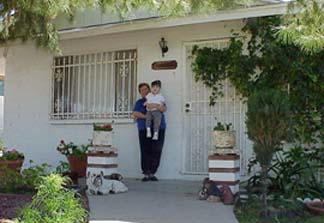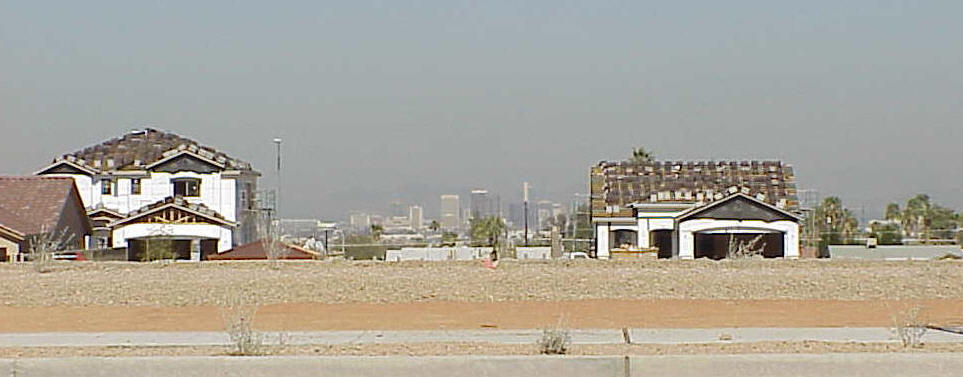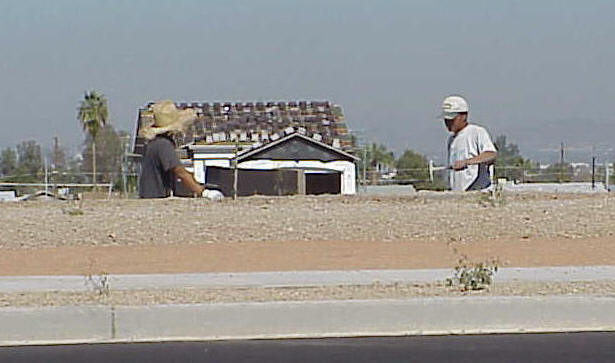 \
\
 \
\
By: Yolanda Anita Sanchez

South of Dobbins, west of 7th
Avenue is the place Cecelia has called home.
 The
neighborhood has been standing, with its spectacular, one-of-a-kind view of the
Valley and South Mountain, for well over
20 years. For the most part, the neighborhood had been viable, quiet, and
happy. Children would play in the street and neighbors would chat from their
porches and look out for each other while overlooking the city. Then, KB Homes
moved next door.
The
neighborhood has been standing, with its spectacular, one-of-a-kind view of the
Valley and South Mountain, for well over
20 years. For the most part, the neighborhood had been viable, quiet, and
happy. Children would play in the street and neighbors would chat from their
porches and look out for each other while overlooking the city. Then, KB Homes
moved next door.
While visiting the development, our team learned that KB Homes is building 190 tract houses, in the price ranges of $130,000-$200,000. The 13 floor-plan, 6 color scheme, different elevation planned community will be complete with two-car garages, stucco, and red tile roofs. (The more things attempt to be different, the more they appear the same.) The new housing development does not make Cecelia mad. The noise and dust may be annoying, but not life-changing for Cecelia. She was content living with the distraction of a 190 house community being built on her front yard – until they started building the wall.
In early
October of 2002, Cecelia awoke to look out her front door.
 But,
instead of seeing the beautiful city; she saw a dark, grey, brick wall. KB
Homes had walled Cecelia off from her Valley view. “The wall was 12 feet
high!” She contends. Cecelia protested that the original buyers of the land
had planned with the community to build a see-through wrought iron fence. When
KB Homes took over the land, they did no consulting with their neighbors. Since
KB Homes did not listen to her single complaints, Cecelia mobilized her
neighborhood.
But,
instead of seeing the beautiful city; she saw a dark, grey, brick wall. KB
Homes had walled Cecelia off from her Valley view. “The wall was 12 feet
high!” She contends. Cecelia protested that the original buyers of the land
had planned with the community to build a see-through wrought iron fence. When
KB Homes took over the land, they did no consulting with their neighbors. Since
KB Homes did not listen to her single complaints, Cecelia mobilized her
neighborhood.
Cecelia’s
neighbors protested KB’s wall. They sent letters to the developers and city
planners. They called their city councilman. The noise they made permitted
them the opportunity to meet with the developers and city leaders.
 Three
meetings, tens of phone calls, and five months later, KB Homes began to tear
down their wall.
Three
meetings, tens of phone calls, and five months later, KB Homes began to tear
down their wall.
Once again, when walking out her front door in the morning, Cecelia has a view of the valley. The wall is being torn down a little each day. She will still have her view with the future wrought iron fence. But, will the fence still represent a wall? Cecelia is content with her view through the fence. But, was Cecelia unconsciously fighting for something more than a view?
Danger of gates
In “Divided we Fall, Gated and Walled Communities in the United States” Edward Blakely and Mary Gail Snyder would argue that the new subdivision gates in South Phoenix would be ones of the security zone category. In such zones, the new residents fear the crime spillover from nearby areas. Additionally, they fear the area residents (ignorance of the unknown). “The gates attempt to protect property and property values.” (Blakely, 1997) The authors argue that gated communities privatize community space, hence may privatize communal services and, more notably, civic responsibilities. Altogether, gated neighborhoods “define boundaries, guarantee property values, and effectively prohibit neighborhood change.”
In “Reflections on Privatopia and the City” Evan McKenzie contends that gated communities “promote homogeneity, exclusiveness, and exclusion.” He conveys that residents share political values, interests, and attitudes. Moreover, they have an unhealthy homogeneity which “deprive people of social resources and thus stultify their lives; promote isolation and conflict between residents of the community and the rest of society; stunt children’s ability to relate to people unlike themselves; and leave residents frozen in their present way of life” (McKenzie, 1994). Furthermore, Blakely and Synder profess that dividing communities promotes homogenous neighborhoods, with residents similar in class, age, and race. Thus, gates reduce the number of contacts with people of different groups. Altogether, such gates “…reduce the potential for people to understand one another and commit themselves to any common or collective purpose” (Blakely, 1997).
Notwithstanding, Blakely and Synder’s field work suggest that no evidence exists of any permanent reduction in crime in gated neighborhoods. Moreover, gates “do nothing to reduce crime arising from residents” (Blakely, 1997). They contend that the actual threat is only perceived; yet the fear is real. The authors further argue that protection from crime depends on active alertness of the neighborhood citizens. In “Bunkering the Poor: Our Fortified Ghettos” Camilo Jose Vergara agrees, “Despite the profusion of physical barriers against crime, the most effective defense is social, as people watch after one another’s dwellings, question strangers, and call the police” (Vergara, 1995). Fortified alls and gates in effect decrease the social commitment of neighborhoods, providing merely a façade of safety.
Conclusion
Cecelia’s neighborhood, local representatives, and KB Homes agreed on a wrought iron fence to replace the brick wall. The wrought iron wall will give back the older neighborhood their view of the city. The salesman at KB Homes told me that the developer lost over $50,000 in total from the incident. The money went to the materials and labor for building and now tearing down the wall. The salesman for KB Homes sadly proclaimed that the loss will be passed on to the buyers.
However,
maybe the new residents will not see the ‘lost’ wall and money as a deficiency.
If the closed community would promote conflict, isolation, and leaderless
children, as research suggests, perhaps it is better unwalled.
 Yet
if the wrought iron fence serves as a “barricade” between the old and new
residents, it makes no difference whether it is a brick wall or a see-through
fence. It only allows Cecelia and her neighbors to see the picture city through
the inaccessible community.
Yet
if the wrought iron fence serves as a “barricade” between the old and new
residents, it makes no difference whether it is a brick wall or a see-through
fence. It only allows Cecelia and her neighbors to see the picture city through
the inaccessible community.
